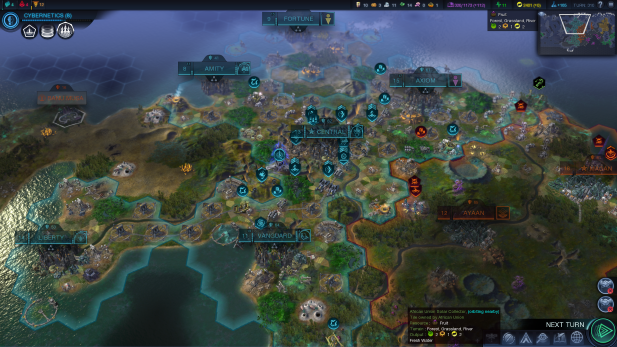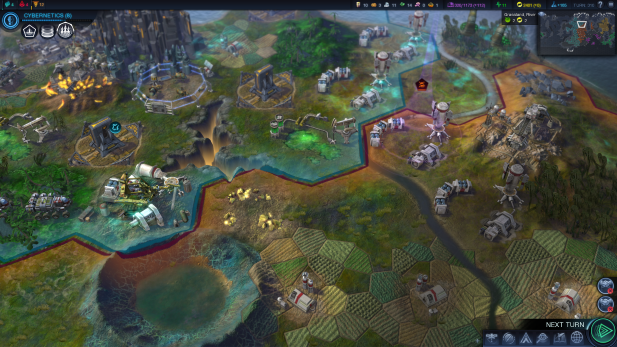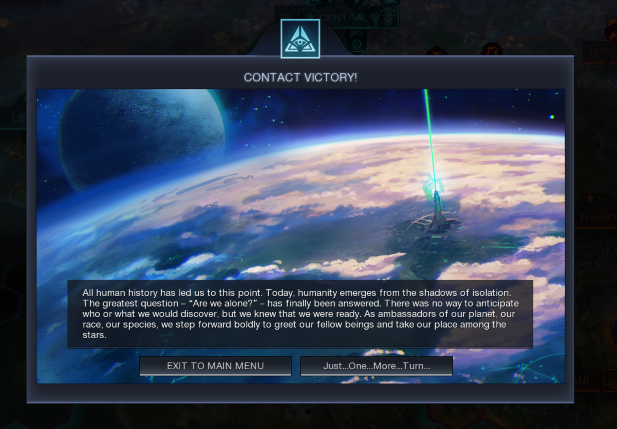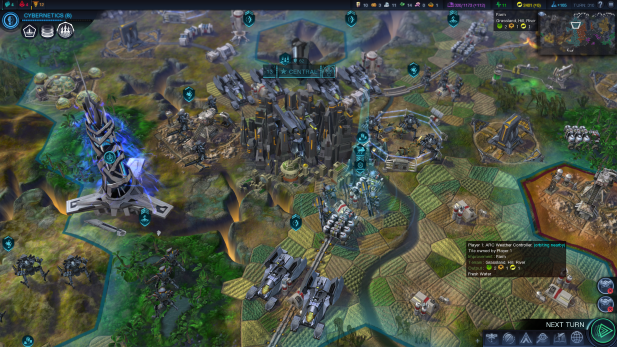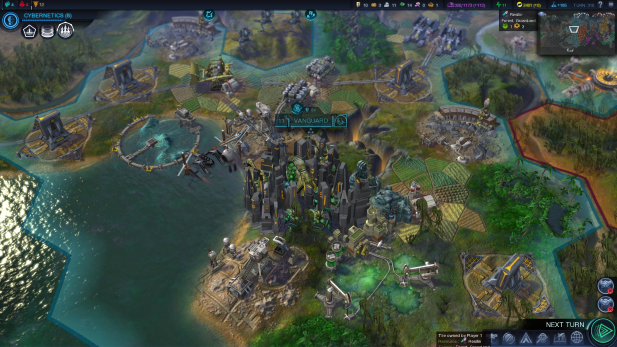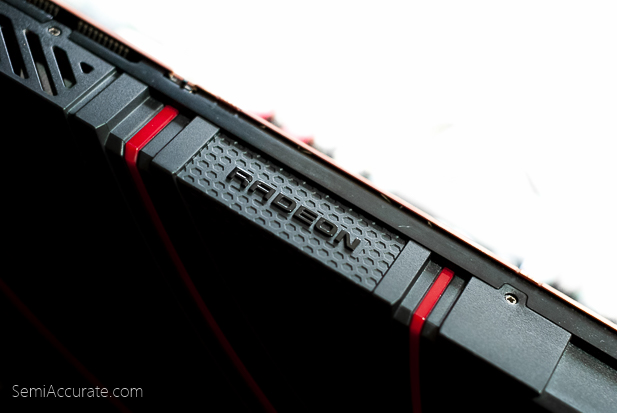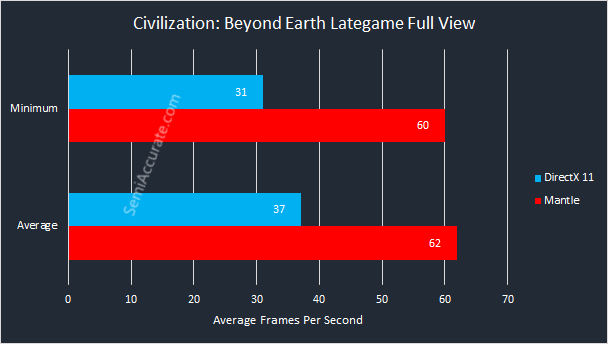Civilization: Beyond Earth shares a lot with its predecessor Civilization V and you’d be forgiven if you confused the two at first glance. But Beyond Earth is a sequel that diverges farther from its predecessor the longer you play it. That said it’s clear that the developers at Firaxis Games looked at Beyond Earth as an evolutionary sequel rather than a revolutionary redesign of the franchise. The game play formula is much the same as it was in Civ V but key elements like the tech tree, city building, diplomacy, city states, and victory conditions have seen major makeovers.
Beyond Earth is a refined and worthy sequel to Civ V. The visual styling is much the same with a simple hex based map and a loosely realistic depiction of far future farms, mines, cities, and geographical features. All of the unit models and many of the unit names have been changed in Beyond Earth. No longer do you send out a band of cave men with pick axes and shovels to establish a new mine or farm, rather futuristic bulldozers take their place. The same is true of ranches where in Civ V they were wood fenced hexes and in Beyond Earth they’ve replaced the wood with lasers, oh joy. Thus in most ways the basic units and city building mechanics in Beyond Earth should be familiar to Civ V players.
But some things have changed for example now when you construct a new city you have to wait a few turns while the outpost that your settlers built matures into a real city based on the worthiness of its location and how many trade convoys you’re sending its way. The outpost is uncontrollable and cannot defend itself until it completes its gestation and becomes a city. This is an interesting wrinkle to the old settle-new-cities formula but I’d argue that it doesn’t actually change the mechanics of expanding your civilization rather it just adds a sense of realism that was missing before and limits the viability of using cities as an instant fortress.
Perhaps the biggest and most meaningful change in Beyond Earth is the new quests system. In prior Civ games players have been allowed to do pretty much whatever they wanted within the bounds of the game. Things are no different in Beyond Earth, but Firaxis has seen fit to incentivize players to meet certain goals by assigning them quests. I would characterize the quest system as being most similar to Minecraft’s implementation due to its unobtrusive nature and the player’s ability to complete quests incidentally as they try to achieve victory.
Whether or not you complete them the presence of quests in Beyond Earth does a lot to build a narrative for a player to follow while helping to prioritize the exploration of important gameplay features like the CIA-style spying system and the exploration of map. The quests system gives players a sense of purpose to the game that Civ V was missing and it makes it a lot easier to get new players invested in the game while teaching them how to play. For more experienced players the quest system acts as a checklist of items to accomplish while they work on implementing their larger strategy.
Accessible through the quests menu are all of the victories in Beyond Earth. Of course you can still win the game merely by crushing all your opponents through military might but Firaxis has introduced a few new endings based on the premise of the Beyond Earth universe. For example I was able to achieve victory by building a giant space antenna based off of a set of blueprints my explorers found in some ruins on the planet’s surface to contact another alien species that left the blue prints on the planet and demonstrate that humanity had finally evolved enough to join the universal community. In another game I built a satellite to contact Earth and then a Stargate-style teleportation device to send giant War-of-the-World’s inspired robot walkers back to Earth to conquer the remains of humanity and rebuild old earth in the image of the new paradise my people had built on this unnamed planet. Clearly the developers had some fun coming up with these victory conditions and the amount of thought that went into them is evident.
The new tech tree is quite different than in Civ V. First off when choosing a technology to research you’re greeted with a cob web-like flow chart of options some of which are inaccessible due to un-researched prerequisite technologies and others that are grouped together due to their similarities. Initially the layout is a bit obtuse, but once you get used to it finding the technologies that you need to research to reach whatever victory you’re working towards becomes much easier.
The other wrinkle in the tech tree is the presence of the affinity system. Based on what technologies you research you are rewarded with affinity points that enable you to choose upgrades to your military units and unlock new quests. The three different types of affinity points are defined as a desire to merge humanity with the alien flora and fauna found on this planet, a desire to mould this planet into the spitting image of Earth, and a desire to take the best of alien’s, humanity, and our technology and use that to create a super species. I of course am a big fan of the hybrid super species tree but that led to quite a few problems for me. The other civilizations will play attention to what your affinity is and harass you diplomatically and occasionally start wars with you if your affinity differs too much from theirs.
Looking at diplomacy in a broader sense the system is much the same as it was in Civ V. But the AI has been re-tuned to be more rational, unless that’s not what you want in which case the AI can act crazy as well. But on the balance I found AI players are far less annoying than they were in Civ V. Perhaps even to docile as they didn’t immediately declare war on me when they saw that I was building a space antenna to win the game. But tuning AI to meet the expectations of players is a difficult task and Beyond Earth seems to have found a good balance.
City states, now called stations, have also seen a makeover in Beyond Earth and are now mostly trading partners more than anything else. You can no longer buy their admiration through diplomacy and cash payments but you can choose the attributes of the station that settle closest to your civilization. I would go so far as to say that stations are far less important in Beyond Earth than city states were in Civ V; to the point where I mostly ignore them.
The pacing of Beyond Earth is similar to that of Civ V and an average game will take a little over 300 turns with eight players. Like all strategy games there is a palpable slow down between turns as the game goes along and the AI’s turns are calculated. Subjectively the slowdown is smaller in Beyond Earth but its presence remains and it is my biggest problem with Civilization-style games as it incentivizes me to leave and go do something else while it works itself out. When, or if, Firaxis ever manages to solve this performance problem prepare to find me rejoicing out in the streets.
Speaking of performance; Civilization: Beyond Earth is a Gaming Evolved title and for the sake of transparency we want you to know that we received a pre-release copy of the game from AMD through Steam so we could conduct our testing for this review. We also tested this game on a PC build on Intel’s Core i7-5960X on Gigabyte’s X99-UD7 motherboard with RAM and water-cooling from Corsair and a reference Radeon R9 290X send to us by AMD.
We tested Beyond Earth on the Ultra present with at 1080P with 8x MSAA and V-sync disabled.
We were expecting to see a small performance bump from using Mantle based on the graphs that AMD supplied in its reviewers guide. Much to our surprise though using Mantle doubled and nearly doubled minimum and average frame rates respectively. It’s important to note that frame rates were measured using the lowest performance slice of Beyond Earth’s built-in late game benchmark. Thus these numbers are as close to a pathological worst case scenario as you’re going to get and as always your mileage may vary. With all of that said it appears that Mantle really unlocks the rendering bottleneck present in DirectX 11. We probably shouldn’t be surprised though as Civ games are almost always CPU hogs and Mantle is designed to free up resources on just that. Subjectively and with Vsync off, there was less stuttering and tearing using the Mantle version of Beyond Earth.
It’s also worth noting that Mantle is drastically more power efficient than DirectX 11. It also has significantly more consistant power draw numbers. Such a pattern could alude to Mantle doing a better job of keeping our R9 290X fed than DirectX 11.
At the end of the day Civilization: Beyond Earth is a great game and it’s clear that it makes good use of AMD’s Mantle API.S|A
Thomas Ryan
Latest posts by Thomas Ryan (see all)
- Intel’s Core i7-8700K: A Review - Oct 5, 2017
- Raijintek’s Thetis Window: A Case Review - Sep 28, 2017
- Intel’s Core i9-7980XE: A Review - Sep 25, 2017
- AMD’s Ryzen Pro and Ryzen Threadripper 1900X Come to Market - Aug 31, 2017
- Intel’s Core i9-7900X: A Review - Aug 24, 2017
